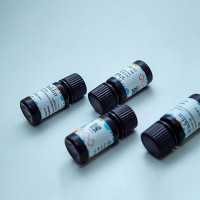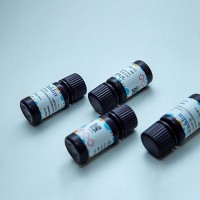Measurement of Chloride Movement in Neuronal Preparations
互联网
- Abstract
- Table of Contents
- Materials
- Figures
- Literature Cited
Abstract
In this unit, protocols are described for biochemical and optical techniques that have been used by investigators to measure ligand?gated chloride movement in vesicular structures called synaptoneurosomes (also referred to as microsacs), in cultured neurons, and in the acute brain slice. These techniques can be applied to other ions as well. The measurement of uptake and efflux of radioisotopic chloride in synaptoneurosomes is used to study the responses of gamma?aminobutyric acid (GABA) receptors, which are coupled to chloride channels. Similar chloride flux assays for primary neuronal cultures are also presented. Alternatively, the efflux of chloride from synaptoneurosomes and primary neuronal cultures can be studied using fluorescent dyes and photometry. Finally, the measurement of chloride uptake can be studied in individual neurons in brain slices using fluorescent dyes and optical imaging by nonconfocal and confocal microscopy. Several support protocols are provided as well, outlining the preparation of synaptoneurosomes from specific brain regions, and the preparation, loading, and calibration of chloride?sensitive fluorescent dyes.
Table of Contents
- Basic Protocol 1: Uptake/Efflux of Radioisotopic Cl− in Synaptoneurosomes
- Basic Protocol 2: Uptake of Radioisotopic Cl− in Primary Cultures
- Basic Protocol 3: Efflux of Cl− in Synaptoneurosomes Measured with Fluorescent Dyes and Photometry
- Support Protocol 1: Preparation of Synaptoneurosomes
- Basic Protocol 4: Efflux of Cl− in Primary Cultures Measured with Fluorescent Dyes and Photometry
- Basic Protocol 5: Uptake of Cl− in the Acute Brain Slice Measured with Fluorescent Dye and Epifluorescence Imaging
- Alternate Protocol 1: Uptake of Cl− in the Acute Brain Slice Measured with Fluorescent Dye and Confocal Imaging
- Support Protocol 2: Preparation of MEQ‐Loaded Acute Brain Slices
- Support Protocol 3: Calibration of Fluorescent Dye in Synaptoneurosomes and Cultured Cells
- Support Protocol 4: Calibration of Fluorescent Dye In Brain Slices
- Reagents and Solutions
- Commentary
- Literature Cited
- Figures
Materials
Basic Protocol 1: Uptake/Efflux of Radioisotopic Cl− in Synaptoneurosomes
Materials
Basic Protocol 2: Uptake of Radioisotopic Cl− in Primary Cultures
Materials
Basic Protocol 3: Efflux of Cl− in Synaptoneurosomes Measured with Fluorescent Dyes and Photometry
Materials
Support Protocol 1: Preparation of Synaptoneurosomes
Materials
Basic Protocol 4: Efflux of Cl− in Primary Cultures Measured with Fluorescent Dyes and Photometry
Basic Protocol 5: Uptake of Cl− in the Acute Brain Slice Measured with Fluorescent Dye and Epifluorescence Imaging
Materials
Alternate Protocol 1: Uptake of Cl− in the Acute Brain Slice Measured with Fluorescent Dye and Confocal Imaging
Support Protocol 2: Preparation of MEQ‐Loaded Acute Brain Slices
Materials
Support Protocol 3: Calibration of Fluorescent Dye in Synaptoneurosomes and Cultured Cells
Materials
Support Protocol 4: Calibration of Fluorescent Dye In Brain Slices
|
Figures
-

Figure 7.10.1 A typical filtration apparatus. The stainless steel filter holder has two parts; the glass fiber filter is placed on the mesh support and then wet with buffer to keep it in place. The entire unit is placed onto the vacuum flask for filtration. View Image -

Figure 7.10.2 A typical concentration‐response experiment for muscimol‐induced 36 Cl− uptake in cerebral cortical synaptoneurosomes is shown (see ). Values obtained in dpm (average of triplicates) have been converted to nmol of 36 Cl− taken up per mg of synaptoneurosomal protein in a 5‐sec period. View Image -

Figure 7.10.3 A model experiment showing responses of synaptoneurosomes loaded with Cl− ‐sensitive fluorescent dye (see ) upon addition of substances that change the intrasynaptoneurosomal Cl− concentration. This is also applicable to dye‐loaded cultured cells (see ). GABA and barbiturate cause increases in the fluorescence in response to the efflux of Cl− through GABAA receptor–coupled Cl− channels. The intracellular Cl− concentration is estimated (see 3) by adding nigericin and tributyltin (which equalize the Cl− gradient and give maximal fluorescence), and valinomycin and KSCN (which cause quenching of the dye and give minimal fluorescence). View Image -

Figure 7.10.4 A typical brain slice superfusion (imaging) chamber. The chamber is made of Plexiglas with two wells for filling and removing buffer from the chamber. The wells are connected to the central chamber by a thin tunnel to allow the buffer to fill the central chamber. The slice is placed in the central chamber and the harp is placed on top of the slice to keep it from moving. A single inflow tube is shown here. For treatment of dye‐loaded slices with GABA or other agonists, a separate reservoir is used, and a switch valve is used to alternate between perfusion media. View Image -

Figure 7.10.5 Pseudocolor‐enhanced video images from a typical confocal imaging experiment in an acute brain slice. The response of individual pyramidal neurons in area CA1 of hippocampus, loaded with MEQ, to 100 µM GABA (see ) is shown. The left panel shows fluorescence before the addition of GABA (basal) and the right panel shows the fluorescence 20 min after the addition of a maximally effective concentration of GABA (100 µM) to the perfusion medium. At 20 min after application, GABA produced an average Δ F of 22%. Note that one cell was relatively insensitive to GABA. View Image
Videos
Literature Cited
| Literature Cited | |
| Biwersi, J. and Verkman, A.S. 1991. Cell‐permeable fluorescent indicator for cytosolic chloride. Biochemistry 30:7879‐7883. | |
| Cala, P.M. 1990. Principles of cell volume regulation: Ion flux pathways and the roles of anions. In Chloride Channels and Carriers in Nerve, Muscle, and Glial Cells (F.J. Alvarez‐Leefmans and J.M. Russell eds.) pp. 67‐83. Plenum, New York. | |
| Dunn, S.M.J., Shelman, R.A., and Agey, M.W. 1989. Fluorescence measurements of anion transport by the GABAA receptor in reconstituted membrane preparations. Biochemistry 28:2551‐2557. | |
| Engblom, A.C. and Åkerman, K.E.O. 1991. Effect of ethanol on γ‐aminobutyric acid and glycine receptor‐coupled chloride fluxes in rat brain synaptoneurosomes. J. Neurochem. 57:384‐390. | |
| Engblom, A.C. and Åkerman, K.E.O. 1993. Determination of the intracellular free Cl− concentration in rat brain synaptoneurosomes using a Cl− sensitive fluorescent indicator. Biochim. Biophys. Acta 1153:262‐266. | |
| Engblom, A.C., Holopainen, I., and Åkerman, K.E.O. 1989. Determination of GABA receptor‐linked chloride fluxes in rat cerebellar granule cells using a fluorescent probe SPQ. Neurosci. Lett. 104:326‐330. | |
| Hara, M., Inoue, M., Yasukura, T., Ohnishi, S., Mikami, Y., and Inagaki, C. 1992. Uneven distribution of intracellular Cl− in rat hippocampal neurons. Neurosci. Lett. 143:135‐138. | |
| Harris, R.A. and Allan, A.M. 1985. Functional coupling of γ‐aminobutyric acid receptors in chloride channels in brain membranes. Science 228:1108‐1110. | |
| Hollingsworth, E.B., McNeal, E.T., Burton, J.L., Williams, R.J., Daly, J.W., and Creveling, C.R. 1985. Biochemical characterization of a filtered synaptoneurosome preparation from guinea pig cerebral cortex: Cyclic adenosine 3′:5′‐monophosphate‐generating systems, receptors, and enzymes. J. Neurosci. 5:2240‐2253. | |
| Illsley, N.P. and Verkman, A.S. 1987. Membrane chloride transport measured using a chloride‐sensitive probe. Biochemistry 26:1215‐1219. | |
| Inglefield, J.R. and Schwartz‐Bloom, R.D. 1997. Confocal imaging of intracellular chloride in living brain slices: Measurement of GABAA receptor activity. J. Neurosci. Methods. 75:127‐135. | |
| Inomata, N., Ishihara, T., and Akaike, N. 1988. Effects of diuretics on GABA‐gated chloride current in frog isolated sensory neurones. Br. J. Pharmacol. 93:679‐683. | |
| Kardos, J. and Maderspach, K. 1987. GABAA receptor‐controlled 36Cl− influx in cultured rat cerebellar granule cells. Life Sci. 41:265‐272. | |
| Krapf, R., Berry, C.A., and Verkman, A.S. 1988. Estimation of intracellular chloride activity in isolated perfused rabbit proximal convoluted tubules using a fluorescent indicator. Biophys. J. 53:955‐962. | |
| Lehoullier, P.F. and Ticku, M.K. 1989. The pharmacological properties of GABA receptor‐coupled chloride channels using 36Cl− influx in cultured spinal cord neurons. Brain Res. 487:205‐214. | |
| Lipton, P., Aitken, P.G., Dudek, F.E., et al. 1995. Making the best of brain slices: Comparing preparative methods. J. Neurosci. Methods 59:151‐156. | |
| Lovrien, R. and Matulis, D. 1995. Assays for total protein. In Current Protocols in Protein Science (J.E. Coligan, B.M. Dunn, H.L. Ploegh, D.W. Speicher, and P.T. Wingfield, eds.) pp. 3.4.1‐3.4.24. John Wiley & Sons, New York. | |
| Majewska, M.D., Harrison, N.L., Schwartz, R.D., Barker, J.L., and Paul, S.M. 1986. Steroid hormone metabolites are barbiturate‐like modulators of the GABA receptor. Science 232:1004‐1007. | |
| Morrow, A.L. and Paul, S.M. 1988. Benzodiazepine enhancement of γ‐aminobutyric acid‐mediated Cl− ion flux in rat brain synaptoneurosomes. J. Neurochem. . 50:302‐306. | |
| Nachshen, D.A. and Blaustein, M.P. 1980. Some properties of potassium‐stimulated calcium influx in presynaptic nerve endings. J. Gen. Physiol. 76:709‐729. | |
| Pearce, R.A. 1993. Physiological evidence for two distinct GABAA responses in rat hippocampus. Neuron 10:189‐200. | |
| Puia, G., Costa, E., and Vicini, S. 1994. Functional diversity of GABA‐activated chloride currents in Purkinje versus granule neurons in rat cerebellar slices. Neuron 12:117‐126. | |
| Schwartz, R.D. and Yu, X. 1995. Optical imaging of intracellular chloride in living brain slices. J. Neurosci. Methods 62:185‐192. | |
| Schwartz, R.D., Skolnick, P., Hollingsworth, E.B. and Paul, S.M. 1984. Barbiturate and picrotoxin‐sensitive 36Cl− efflux in rat cerebral cortical synaptoneurosomes. FEBS Lett. 175:193‐196. | |
| Schwartz, R.D., Jackson, J.A., Weigert, D., Skolnick, P., and Paul, S.M. 1985. Characterization of barbiturate‐stimulated chloride efflux from rat brain synaptoneurosomes. J. Neurosci. 11:2963‐2970. | |
| Schwartz, R.D., Suzdak, P.D., and Paul, S.M. 1986. γ‐Aminobutyric acid (GABA)‐ and barbiturate‐mediated 36Cl− uptake in rat brain synaptoneurosomes: Evidence for rapid desensitization of the GABA receptor‐coupled chloride ion channel. Mol. Pharmacol. 30:419‐426. | |
| Suzdak, P.D., Schwartz, R.D., Skolnick, P., and Paul, S.M. 1986. Ethanol stimulates γ‐aminobutyric acid receptor‐mediated chloride transport in rat brain synaptoneurosomes. Proc. Natl. Acad. Sci. U.S.A 83:4071‐4075. | |
| Thampy, K.G. and Barnes, E.M. Jr. 1984. γ‐Aminobutyric acid‐gated chloride channels in cultured cerebral neurons. J. Biol. Chem. 259:1753‐1757. | |
| Ticku, M.K. and Olsen, R.W. 1977. γ‐Aminobutyric acid‐stimulated chloride permeability in crayfish muscle. Biochim. Biophys. Acta 464:519‐529. | |
| Ticku, M.K., Lowrimore, P., and Lehoullier, P. 1986. Ethanol enhances GABA‐induced 36Cl− influx in primary spinal cord cultured neurons. Brain Res. Bull. 17:123‐126. | |
| Verkman, A.S. 1990. Development and biological applications of chloride sensitive fluorescent indicators. Am. J. Physiol. 259:C375‐C388. | |
| Verkman, A.S., Sellers, M.C., Chao, A.C., Leung, T., and Ketcham, R. 1989. Synthesis and characterization of improved Cl− sensitive fluorescent indicators for biological applications. Anal. Biochem. 178:355‐361. | |
| Wong, E.H.F., Leeb‐Lundberg, L.M.F., Teichberg, V.I., and Olsen, R.W. 1984. γ‐Aminobutyric acid activation of 36Cl− flux in rat hippocampal slices and its potentiation by barbiturates. Brain Res. 303:267‐275. |







